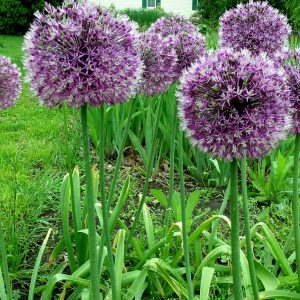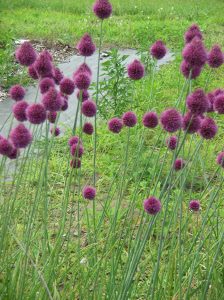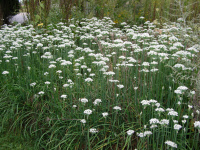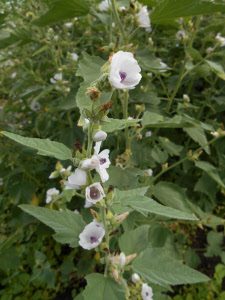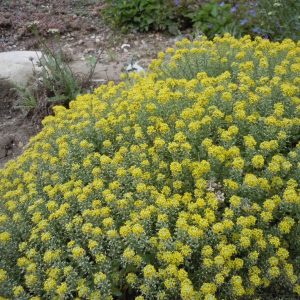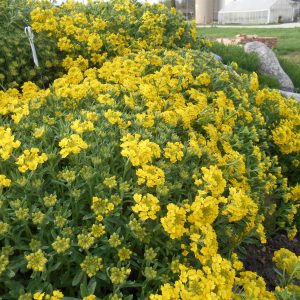Shop
Showing 41–48 of 778 results
-
Allium rosenbachianum Z 5-9
Decadent, huge purple balls in June
OUT OF STOCK
Note: This is a plant not currently for sale. This is an archive page preserved for informational use.Decadent, huge purple balls in June
Size: 36”x 6”
Care: full to part sun in moist well-drained to well-drained soil
Native: TurkestanCollected from the wild about 1894.
1st described by German botanist Eduard August von Regel (1815-1892) who served as the Director of the Imperial Botanical Garden of St. Petersburg Russia -
Allium senescens Corkscrew allium, German garlic, Greater mountain garlic Z 4-9
Lavender balls, up to 30 of them, atop thin, bluish, strap-like, twisting foliage – mid-summer day’s dream.
Lavender balls, up to 30 of them, atop thin, bluish, strap-like, twisting foliage – mid-summer day’s dream.
Size: 6-12” x 6-12”
Care: sun to part shade in well-drained to moist well-drained soil
Native: Siberia
Wildlife Value: attracts butterflies & bees, deer & rabbit resistantCultivated before 1753. According to Philip Miller’s 1768 Dictionary, “planted in gardens for the variety of their flowers.”
-
Allium sphaerocephalon Drumstick allium Z 4-11
Claret colored, egg shaped flower heads
Claret colored, egg shaped flower heads top leafless stems in June to July. Good see-through plant to intermingle with purple coneflowers or tickseed. Good cut flower. Self-sows
Size: 2-3’ x 2-3”
Care: sun in well-drained to moist well-drained soil.
Native: Mediterranean, Caucasus & Europe
Wildlife Value: attracts bees, butterflies and other insects.In gardens before 1750. Used as an edging around vegetables at Mount Vernon.
-
Allium tuberosum Garlic chives
August & September bright white balls the size of golf balls on erect stems. Pretty in fall gardens.
August & September bright white balls the size of golf balls on erect stems. Pretty in fall gardens.
Size: 12-18” x 8”
Care: Full sun or shade in any soil
Native: SW Shanxi China
Wildlife Value: nectar source for many butterlies including the Tiger Swallowtail.Used medicinally in Asia as a remedy for incontinence, bladder weakness, kidney trouble and knee injuries. Traditional Chinese medicine practitioners made a powder from the seeds called Jiu Cai Zi used for numerous ailments. Widely grown as a vegetable.
-
Althaea officinalis Marshmallow Z 4-9
Small pale pink mallow-like blooms climb tall spires from July to September
Small pale pink mallow-like blooms climb tall spires from July to September
Size: 5-6’ x 3’
Care: Full sun moist to moist well-drained fertile soil. Heat and drought tolerant, stands up to wind.
Native: Central, south and east EuropeAlthaea is Greek meaning “to cure.” This was identified by Dioscorides in De Materica Medica for medicinal use around 70 A.D. More than 2000 years ago ancient Egyptians added honey to the cooked root. Ancient Romans used leaves and flowers as a strewing herb to repel lice and fleas. Emperor Charlemagne (742-814) cultivated the marshmallow in his gardens. According to Nicholas Culpepper, 16th century English herbalist, marshmallows were a medicinal candy. The plant eased pain, helped bloody fluxes, the stone and gravel and gripping of the belly. The marshmallow was considered to be an herb of Venus meaning that it voided offensive humors, made milk for nursing, cured bee stings, dandruff, balding and coughs. The French concocted the fluffy white confection in the mid 1800’s “from a decoction of marshmallow root, with gum to bind the ingredients together, beaten egg white to give lightness and to act as a drying agent, while sugar was incorporated to make the whole palatable.” American gardens since 1700’s when John Bartram (1699-1777) received seeds from Europe. Jefferson grew it at Monticello. Grown at America’s 1st botanic garden, Elgin Botanic Garden 1811.
-
Alyssum oxycarpum Z 4-9
Rare plant with bright yellow racemes in May to August over compact mound of bright silver foliage.
ARCHIVED
Note: This is a plant not currently for sale. This is an archive page preserved for informational use.
Rare plant with bright yellow racemes in May to August over compact mound of bright silver foliage.
Size: 6” x 8”
Care: sun in moist well-drained soil
Native: TurkeyDescribed in botanical literature in 1856. One of my favorites for rock gardens or any sunny spot, due to its long bloom, yellow mounded blooms & compact silver foliage.
-
Alyssum wulfenianum syn. Alyssum ovirense Alpine alyssum, Madwort Z 3-9
Spring to early summer, clumps of sunny yellow blooms over gray foliage
OUT OF STOCK
Spring to early summer, clumps of sunny yellow blooms over gray foliage
Size: 4-6” x 12-18”
Care: sun in well-drained soil
Native: GermanyDescribed in Willdenow’s Enum. pl. suppl. Before 1814. Grown at the Agricultural Center in Beltsville Maryland in 1897.
-
Amorpha canescens Lead plant Z 2-9
Arching violet spikes flower in mid-summer top pinnately compound, grey-green leaves.
Arching violet spikes flower in mid-summer top pinnately compound, grey-green leaves. Liberty Hyde Bailey (1933): “Handsome free-flowering shrub of dense habit, well adapted for rockeries and borders …”
ONLY AVAILABLE TO SHIP IN EARLY SPRING, WHILE DORMANT. (USUALLY APRIL/MAY)
Size: 2-4’ x 2-3’
Care: sun in well-drained to moist well-drained soil, drought tolerant.
Native: Broad swath of central No. America from Canada to TX. Wisconsin native. Common shrub in Great Plains’ tall-grass prairies and seasonally wet soil.
Wildlife Value: Honeybees and butterflies; especially Whitney's Underwing, relish its nectar. Supports over 50 bee species.
Awards: Great Plants for Great PlainsAmorpha means “deformed” in Greek and “becoming grey” in Latin. Called Lead plant due to old belief that plant grew in soil containing lead. 1st described in published work in 1813. Used medicinally by numerous Native Americans to kill pinworms, remedy eczema, stomach aches, neuralgia, rheumatism and cuts. Steeped leaves made tea for Oglala. Oglala mixed its dried leaves with buffalo fat for smoking. Winnebago powdered the leaves, added water and applied it to skin to remedy scalds. They also ate the roots. Sioux: A tea made from leaves drank as a beverage, treated flu related congestion and as a bath for eczema. Dried leaves part of mixture for smoking. Pre-bison hunt ceremony used stems.

